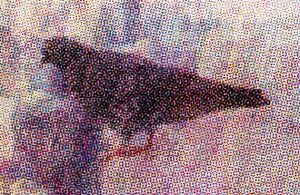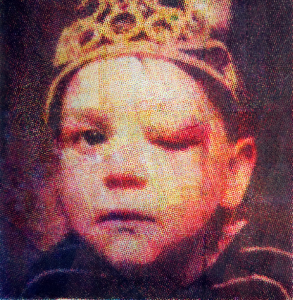//Tami Tedesco
//Section 1 (9:30)
//ttedesco@andrew.cmu.edu
//Project-02
var eyeSize = 20;
var faceWidth = 100;
var faceHeight = 150;
var mouthHeight = 80;
var mouthWidth = 80;
var browWidth = 25;
var browHeight = 5;
var rectCorner = 20;
function setup() {
createCanvas(300, 300);
//random color fill
r = random(255);
g = random(255);
b = random(255);
}
function draw() {
background('#FBFF98');
strokeWeight(4);
//head
fill(r, g, b, 127);
rect(width / 2, height / 2, faceWidth, faceHeight, rectCorner);
fill(51);
var eyeLX = width / 2 - faceWidth * 0.25;
var eyeRX = width / 2 + faceWidth * 0.25;
ellipse(eyeLX, height / 2, eyeSize, eyeSize);
ellipse(eyeRX, height / 2, eyeSize, eyeSize);
//mouth
fill('#FFFFFF')
arc(150, 175, mouthWidth, mouthHeight, 0, PI, CHORD);
//eyebrows
//L
fill('#000000')
rectMode(CENTER);
translate(width/2, height/2);
rotate(HALF_PI/3.0);
rect(-35, -10, browWidth, browHeight);
//R
fill('#000000')
rectMode(CENTER);
rotate(-PI/3.0);
rect(35, -10, browWidth, browHeight)
}
function mousePressed() {
r = random(255);
g = random(255);
b = random(255);
faceWidth = random(70, 150);
faceHeight = random(100, 200);
eyeSize = random(10, 30);
mouthWidth = random(20, faceWidth);
mouthHeight = random(20, faceHeight/2);
browWidth = random(20, 40);
browHeight = random(2, 15);
rectCorner = random(0, 250)
}So this is my variable face program! It generates a randomly colored face making different degrees of the >:D emoticon, which is one I use a lot when I text. In addition, the face shape, mouth size, eye size, and eyebrow size are all also randomly generated. The character of the >:D expression changes a bit depending on the facial structure behind it, so I wanted to explore that aspect with this program.
![[OLD – FALL 2016] 15-104 • COMPUTING for CREATIVE PRACTICE](../../wp-content/uploads/2020/08/stop-banner.png)

